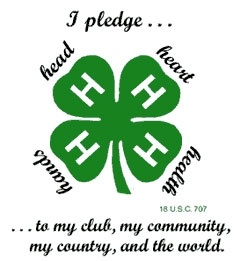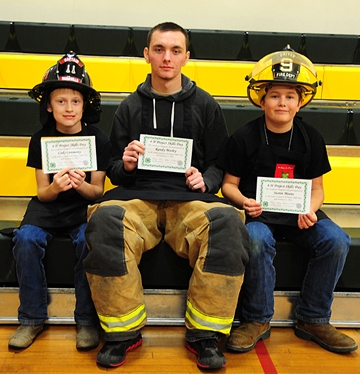Posts Tagged: Pleasants Valley 4-H Club
Monkey bread: It's more fun than a barrel of....
The skills learned in the UC Agriculture and Natural Resources 4-H Youth Development program last a lifetime, but in the case of a really good, quick-and-easy recipe for Monkey Bread, the skills last but the bread doesn't.
Okay, who ate the last piece? Umm, when will you be making more?
Maya Farris, 9, a second-year 4-H'er, may be fairly new to 4-H but she knows how to make a good batch of “Monkey Bread.” A member of the Pleasants Valley 4-H Club in Vacaville, she won a showmanship award at the Solano County 4-H Project Skills Day with her “Monkey Bread” entry and then went on to enter the project—and wow the judges—at the Solano County 4-H Presentation Day.
We watched folks line-up for a sample of her monkey bread at Project Skills Day, and then watched her expertly answer questions from judges at the Presentation Day.
Before we give you the recipe, first, a little bit about Maya. She's one busy 4-H'er. Her current projects are baking and bread making, arts and crafts, rabbits, poultry, goats and crocheting. She learned how to make monkey bread from her baking and breadmaking project. She thoroughly enjoyed the recipe, as did her family and friends.
The Farris family is sold on 4-H. “4-H has really helped Maya become focused and experience different activities that she may not have otherwise tried,” mother Rayita said. “4-H is definitely a family affair; her older sister is also involved in 4-H and in many projects.”
The monkey bread recipe is a five-ingredient recipe, perfect for busy days:
Monkey Bread Recipe
Prepared by Maya Farris,
Pleasants Valley 4-H Club, Vacaville
1 can refrigerated biscuits (16.3 oz)
1/4 cup sugar
1/2 teaspoon cinnamon
1/3 cup brown sugar
1/4 cup melted butter
Mix sugar and cinnamon in a large ziplock bag and set aside. Cut each biscuit into quarters and place in zip lock bag, a few at a time. Shake to coat and place pieces in a greased 8" loaf pan. Combine melted butter and brown sugar and pour over the coated biscuit pieces. Bake at 350 degrees for 40 minutes or until golden brown. Let cool 5 minutes, then turn over onto a serving plate. Serve warm.
Meanwhile, what do you know about monkey bread? Actor Robert Duvall couldn't get enough of it. Kids grab it and pull it apart like toys after Christmas. Nancy Reagan served it in the White House. Texan Anne King created a legend.
One of my Texas relatives gifted me with Tom Perini's Texas Cowboy Cooking cookbook which includes Anne King's famous Monkey Bread recipe. Robert Duvall wrote the foreword to the book after enjoying Tom Perini's cooking in between scenes of the Warner Brothers' 1995 movie, “Stars Fell on Henrietta.”
Duvall starred as a destitute wildcat oilman who lands in the town of Henrietta, Texas, during the Depression. Duvall thinks there's oil — aka black gold, Texas tea — on a poor cotton grower's farm. He convinces the farmer to go for broke. Director James Keach filmed the Clint Eastwood-produced movie near Buffalo Gap, Texas, which just happened to be near the Perini Ranch Restaurant.
“After Clint Eastwood and I ate our first meal there, the cast and crew returned for dinner as often as we could,” Duvall writes in the foreword. Guess you could say they took a'likin' to the restaurant. They loved the “good eats,” including Monkey Bread.
Anne King of Albany, Texas, rose to fame (maybe not fortune) with Monkey Bread and shipped it all over the country. It's also called a pull-apart bread or bubble bread because of the layers of dough squares or rolled balls baked together in a tube or bundt pan.
No one really knows how “monkey” became part of the name. Maybe someone was just monkeying around or figured the bread resembled the monkey puzzle tree. Then again, there's a fruit called “monkey bread” from the baobab tree or monkey bread tree. Nancy Reagan helped popularize the odd-sounding bread in the 1980s when she served it in the White House.
Here's Anne King's famous Monkey Bread recipe from Tom Perini's Texas Cowboy Cooking book.
Monkey Bread
By Anne King
1 cup scalded milk
1/2 cup vegetable shortening
1 cup mashed potatoes
1 teaspoon salt
1/2 cup sugar
One 1-ounce cake of yeast or 1-1/2 packets of dry yeast
1/2 cup warm water
3 eggs, beaten
6 cups flour
1/2 cup butter
Mix together the hot milk and shortening. Add the potatoes, salt and sugar. Set aside to cool to lukewarm. Dissolve the yeast in the water, and add to the potato mixture. Add the beaten eggs. Add 5 cups of the flour, 1 cup at a time, mixing well after each addition. Turn out the dough onto a floured board. Sprinkle the dough with 1/3 cup flour. Knead the dough thoroughly, adding a little more flour if the dough is sticky. Place in a greased bowl, cover and let rise for 2 hours.
Melt the butter in a shallow bowl. Roll out the dough on a floured board into a rectangular shape to a thickness of about 1/2-inch. Cut into 2-inch squares. Dip the squares into the melted butter and arrange in the bottom of a tube pan (bundt cake pan). The squares should overlap slightly. Continue to add layers until the dough is used up. Set aside to rise again until double in size, about an hour. Bake at 400 degrees for 25 minutes. Loosen the sides of the monkey bread rings with a table knife. Turn out the monkey bread and let guests pull apart the squares to serve themselves. You may bake in smaller pans, just be sure to reduce the cooking time slightly, maybe 15 to 20 minutes. Makes 1 large loaf.
Texas Cooking (www.texascooking.com) offers a version of Monkey Bread with cinnamon. It's shaped into balls instead of squares and is made with cinnamon and pecans. This bread can be mixed in the traditional manner, by hand, or in the dough cycle of your bread machine.
Monkey Bread
Texas Cooking
2-1/4 teaspoons (1 package) active dry yeast
4 cups white flour, plus more for kneading if needed
1 teaspoon salt
1 tablespoon sugar
1 cup warm milk
3/4 cup warm water
3 tablespoons melted butter, divided
1 egg, at room temperature, lightly beaten
1 cup toasted pecans, finely chopped (see Note, below)
2 teaspoons ground cinnamon
2/3 cup light brown sugar
5 tablespoons butter, melted
Lightly grease a 10-inch tube, 9-inch springform or Bundt pan. In a large bowl, combine the yeast, flour, salt and sugar, making a well in the center. In a separate container, stir together the milk, water, 2 tablespoons melted butter and egg. Add the milk mixture to the flour mixture, and stir together to form a soft dough. Turn out onto a lightly floured surface and knead for about 10 minutes, until dough is smooth and elastic. Place dough in a bowl that has been lightly sprayed with vegetable cooking spray. Brush dough with remaining 1 tablespoon melted butter, and cover with waxed paper or plastic wrap.
Let rise in a warm place for 45 to 60 minutes, or until doubled in size. While bread is rising, mix together the toasted pecans, cinnamon and brown sugar. Turn out the dough onto a lightly floured surface and knead gently for two minutes. Divide dough into 30 equal pieces. Shape pieces into balls. Dip each ball into the melted butter, then roll in the pecan mixture. Place in prepared pan. Do not pack pieces together, but leave some space between the dough pieces. Sprinkle any remaining pecan mixture and melted butter over the dough pieces. Cover with waxed paper or plastic wrap and let rise in a warm place for about 45 minutes. Bake in a 375 degree preheated oven for 35 to 40 minutes. Bread should rise well above the top of the pan and be golden brown. Cool on wire rack.
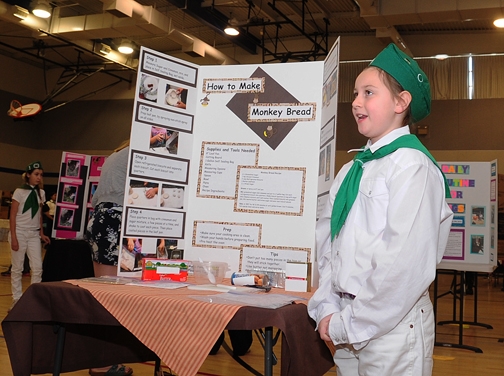
Second-year 4-H'er Maya Farris, 9, of Vacaville, answers questions about her monkey bread display at the Solano County 4-H Presentation Day. (Photo by Kathy Keatley Garvey)
A Super Bowl of Chili: 4-H'ers prepare 4-alarm chili
Making a "super bowl" of chili is also quite timely for Super Bowl Sunday on Feb. 2, when the Denver Broncos try to defeather the Seattle Seahawks.
The Solano County 4-H Program traditionally hosts a chili cookoff at its annual Project Skills Day. All clubs in the county are invited to participate.
This year three boys enrolled in an outdoor cooking project teamed to win the four-way competition, held Jan. 11 at C. A. Jacobs School, Dixon.
Cody Ceremony, Randy Marley and Justin Means, all members of the newly formed Pleasants Valley 4-H Club in Vacaville made “4-Alarm Chili,” obtaining the recipe from Justin's uncle, Chuck Means, engineer with the Sacramento Metropolitan Fire District and a co-community leader of the Dixon Ridge 4-H Club. The boys dressed in firefighter uniforms including helmets and turnouts that Means provided.
The outdoor cooking project is a joint endeavor of the Pleasants Valley and Dixon Ridge clubs.
“We simmered the chili for four hours,” Marley said of the recipe which included both pork and beef, plus four types of peppers: pasilla, serrano, anaheim and green bell.
They said it has "a little kick at the end," but not too much. The "heat" can be adjusted, depending on taste.
Judges scored the teams on temperature (it had to be 140 degrees or more), aroma, flavor, texture and freshness, plus a written recipe (neatness), and the overall presentation (table decor and costumes).
Julie Tanaka, a community leader of the Maine Prairie 4-H Club, Dixon, coordinated the event. Judges were Solano County Supervisor John Vasquez Jr. of Vacaville, Ed Coffelt of the Maine Prairie 4-H Club, and longtime 4-H'er Kathy Keatley Garvey of UC Davis/Vacaville.
"The 4-Alarm Chili was very flavorful, and the team understood the combination of ingredients - the blend of the peppers and the blend of the meats," Vasquez said.
"They all put a lot of work into it," the trio of judges agreed.
Also competing were:
- Want Quackers With Your Chili? Vaca Valley: Makenzie Davi, Marissa Davi and Emma Ryder
- Jeans ‘n Beans, Pleasants Valley: Sabrina Brown, Melanie Campilongo, Lillian Tudbury and David Witzel
- The Persim-Monsters, Suisun Valley: Alexis Taliafero, Clairese Wright and Robert Wright
The Quackers' key ingredient was - guess what! - "duck," purchased at a local market. The Persim-Monsters added persimmons to their chili, while the Jeans ‘n Beans team entered a more traditional chili.
Here's the winning recipe:
4-Alarm Chili
2 pounds of pork shoulder, cut in 1/2-inch chunks
2 pounds ground beef
Olive oil (as needed to brown meat)
2 cans of tomatoes (chopped or diced work best)
2 cans of beans (one kidney and one pinto), drained
2 pasilla peppers
2 serrano peppers
2 Anaheim peppers
2 green bell peppers
2 onions
2 cloves garlic
Water (approximately one cup)
Cornstarch
Seasonings to taste:
Beef bouillon, chili powder, ground cumin, garlic salt and black pepper.
Preparation:
In a large stock pot, brown pork in the olive oil. Add the ground beef and continue cooking over high heat until beef is browned (about 30 minutes). Add the water and seasonings. Cook an additional 30 minutes. Add tomatoes and beans. Turn down heat and simmer for 30 minutes. While mixture is simmering, coarsely chop onions and peppers and finely chop garlic. Add these to the pot and continue cooking until pork is tender (about another 30 to 35 minutes). Check flavor and add seasonings to taste. If needed, thicken chili with cornstarch.
This recipe, featuring ground duck, got high marks from the judges.
Quackers' Chili
2 to 3 pounds ground duck (the 4-H'ers purchased duck at a local supermarket; beef can be substituted)
1 to 2 large onions, chopped
6 cloves garlic, chopped
1 tablespoon dried ground cumin, or to taste
1 tablespoon dried oregano, or to taste
1 tablespoon each of chili powder and cayenne pepper (fresh chile peppers may be substituted)
Coarse salt and fresh ground black pepper, to taste
3 to 4 cups of a combination of tomato puree, tomato sauce and fresh/diced tomatoes
2-1/2 cans (14.5 ounces) of beef broth, red wine, or water can be substituted for some of the liquid (Additional broth, wine or water can be used, as needed)
1 to 2 tablespoons molasses (This helps cut down the acidity of the tomatoes. Honey may also be substituted)
1 can each of black beans and kidney beans, rinsed and drained
Condiments:
Grated cheddar cheese
Sour cream
Chopped green onions
Preparation:
in a large pot over medium-high heat, sauté ground duck, onion and garlic until meat is browned. Add cumin, oregano, chili powder, cayenne pepper, salt and pepper, tomatoes and beef broth. Reduce heat to low and simmer, covered, approximately 3 to 4 hours, stirring often. Additional broth, water or red wine may be added as needed.
Add molasses to taste. Add beans and continue to simmer another 30 minutes. Adjust seasonings to taste.
For maximum flavor, cool chili and refrigerate overnight so flavors will mellow. Chili is best made one day ahead to allow the flavors time to meld.
When ready to serve, skim top of solidified fat, reheat over low heat, and serve with cheese sour cream and green onions.
Solano County 4-H Program
Solano County has a total of 500 members in its 12 clubs. Of the seven cities in the county, Dixon has the most, with five clubs.
The clubs are:
Dixon: Dixon Ridge, Maine Prairie, Roving Clovers, Tremont, and Wolfskill
Fairfield-Suisun: Suisun Valley and Westwind
Rio Vista: Rio Vista 4-H Club
Vacaville: Elmira, Vaca Valley, and Pleasants Valley
Vallejo: Sherwood Forest
More information about the Solano County 4-H program is available from Valerie Williams, Solano County 4-H program representative, Solano County Cooperative Extension, at (707) 784-1319 or vawilliams@ucanr.edu. The website is http://cesolano.ucdavis.edu.
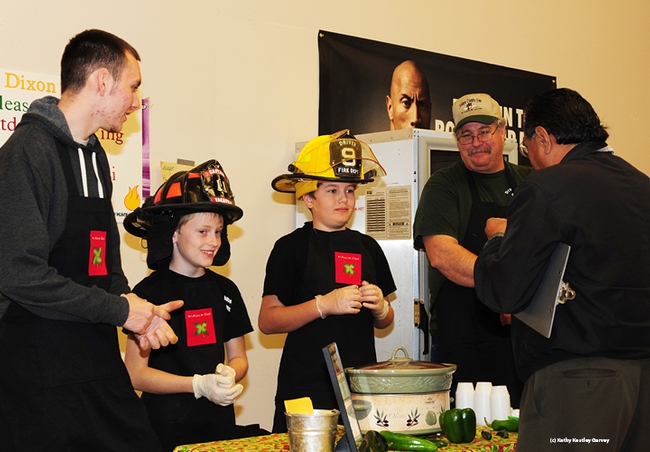
The 4-Alarm Chili Team of the Dixon Ridge 4-H Club and the newly formed Pleasants Valley 4-H Club, watches as judge John Vasquez Jr. samples their dish. From left are Randy Marley, “captain” Cody Ceremony and “driver” Justin Means. In back (at right) is Justin’s uncle, Chuck Means, who provided the recipe and the firefighter uniforms. Chuck Means is an engineer with Sacramento Metropolitan Fire District and a co-community leader of the Dixon Ridge 4-H Club. (Photo by Kathy Keatley Garvey)
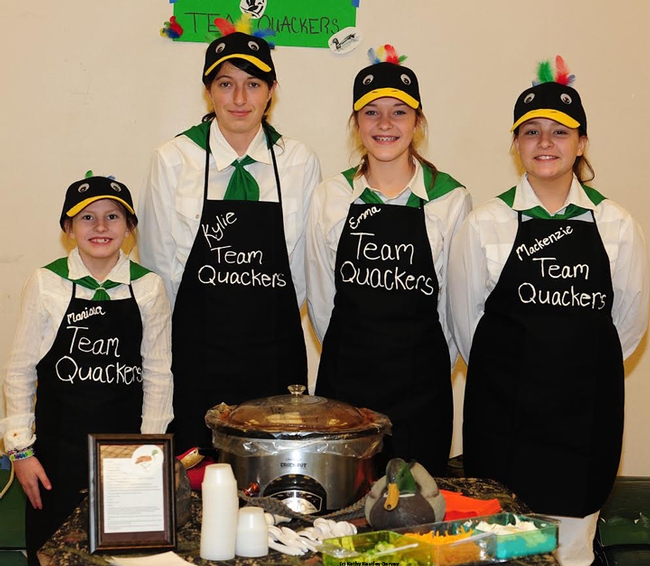
Waiting for judges at the Solano County 4-H Chili Cookoff are Team Quackers (from left) Marissa Davi, Kylie Walker, Emma Ryder and Makenzie Davi, all of the Vaca Valley 4-H Club, Vacaville. Judges praised their chili, which featured duck. For the occasion, they crafted duck hats. They were among four teams competing. The winner: the 4-Alarm Chili, the work of Cody Ceremony, Randy Marley and Justin Means of Dixon Ridge 4-H Club/Pleasants Valley 4-H Club.



